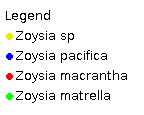Zoysia Ges. Naturf. Freunde Berlin Neue Schriften 3: 440 (1801).
Derivation:. Named for Baron Karl von Zoys, 1756–1800, Austrian botanist.
Key references (keys and floras):. G.Bentham, Flora Australiensis 7: 506 (1878); E.E.Henty, Manual Grasses New Guinea 191 (1969); J.W.Vickery, Flora of New South Wales, Gramineae 19: 302–303 (1975); M.Lazarides, Tropical Grasses S.E. Asia 196 (1980); J.C.Tothill and J.B.Hacker, Grasses of Southern Quennsland 438–439 (1983); J.P.Jessop, Flora of South Australia 4: 1958 (1986); B.K.Simon, Key to Australian Grasses 177 (1993); S.W.L.Jacobs and S.M.Hastings, Flora of New South Wales 4: 505 (1993); N.G. Walsh, Flora of Victoria 2: 581–582 (1994); D.I.Morris, Student's Flora of Tasmania 4B: 332–333 (1994); E.Edgar and H.E.Connor, Flora of New Zealand 5: 515–518 (2000); D.Sharp and B.K.Simon, AusGrass (2002); K.Mallet (ed.), Flora of Australia 44B: Poaceae 3: 263–265 (2005); J.P.Jessop, Grasses of South Australia 407 (2006); S.W.L.Jacobs, R.D.B.Whalley & D.J.B.Wheeler, Grasses of New South Wales, 4th ed, 402 (2008).
W.D.Clayton & S.A.Renvoize, Genera Graminum (1986), genus (435).
Native and naturalised. 10 species, from Mascarene Is. to New Zealand. 2 species in Australia, SA, Qld, NSW, Vic, and Tas. Also New Guinea and Malesia.
Habit. Mat forming perennial, rhizomatous. Leaves conspicuously distichous. Leaf blades very narrow. Ligule a fringed membrane to a fringe of hairs.
Inflorescence. Inflorescence a false spike, with spikelets on contracted axes or a single raceme, a single raceme or spike.
Spikelets. Spikelets laterally compressed or subterete or dorsally compressed, 1 flowered, with 1 fertile floret, solitary, shortly pedicelled. Fertile spikelets adaxial (with lower glume against rachis), falling with glumes (falling singly from the persistent pedicels).
Glumes. Glumes one per spikelet or two, unequal, (the upper) long relative to adjacent lemmas, awned (or mucronate, via the excurrent midnerve) or awnless, dissimilar (the lower when present minute and scarious). Lower glume 0 nerved. Upper glume 1 nerved.
Florets. Fertile florets 1. Lemmas less firm than glumes (hyaline), not becoming indurated, entire at apex, blunt, mucronate, 1 nerved, glabrous. Palea present or absent, when present conspicuous and relatively short or very reduced, 1 nerved or nerveless. Stamens 1 or 3. Grain small, compressed laterally. Hilum short. Embryo large.
Kranz Anatomy. C4, biochemical type PCK (Z. japonica).
2n = 40, 4 ploid, commonly adventive.
Habitat. Xerophytic. Coastal sands and hinterland. Species of open habitats.
Classification. Chloridoideae; Cynodonteae.
Notes. Although the genus has been placed in a tribe Zoysieae (Clayton and Richardson, 1973) or subtribe Zoysiinae of the Chlorideae (Clayton and Renvoize, 1986), Kellogg (pers.com. 2000) recommends ignoring tribes completely in the chloridoids, on the basis of there being no cladistic results to support the traditional groupings.
Types Species. Z. matrella (L.) Merrill.
Biogeographic Element. Clifford & Simon 1981, Simon & Jacobs 1990: Old World Tropics.


